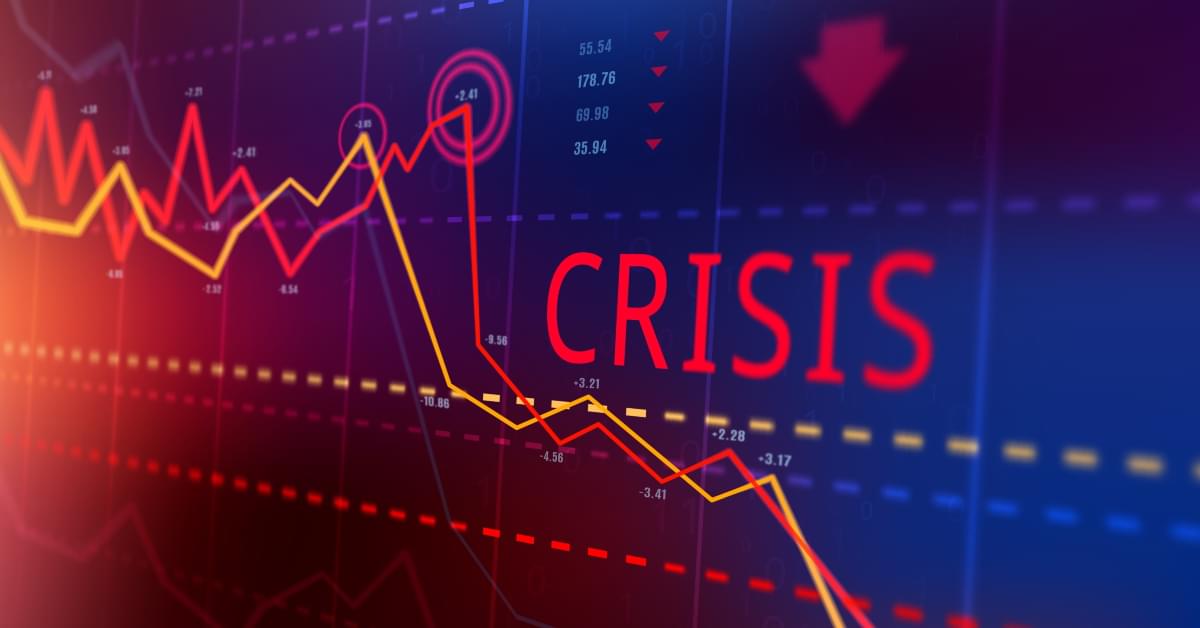
While the US is seeing a strong labour market and is not preparing for recession, the UK is facing the longest recession in history. Meanwhile, the EU balances on the precipice. Should an usually cold winter drive energy prices higher, manufacturers and households will somehow have to withstand skyrocketing bills and CPI inflation. Analysts predict the 27 EU members could contract as much as 5%, matching figures last seen during the 2009 financial crisis.
It is hard to gauge what the global effects of recession will be. Economic downturn in one country can have several knock-on effects in others. For example, the S&P Global Eurozone Manufacturing PMI points towards a fourth consecutive month of falling factory activity in October 2022. If EU manufacturers purchase fewer goods, economies that rely on exports to the EU will suffer pronounced economic contractions.
We can’t tell you for certain when Europe and the US will also tip into recession. However it seems likely to happen soon. In this article we look back at how Europe, the UK and the US dealt with previous crises, and how businesses can prepare for the future. In such a volatile world, it’s never been so crucial to learn how to put in place a solid currency risk management strategy.

2007-2009: Global Financial Crisis
The 2008 crash was the greatest shock to the global financial system in almost a century. It began with a US housing market bubble, created by an overwhelming excess of mortgage-backed securities.
Banks and lending institutions offered low interest rates on mortgages and encouraged many homeowners to take out loans they couldn’t afford.
This reckless lending led an unprecedented number of customers to default on loans. The losses led many financial institutions to declare bankruptcy.
The ECB vs the Fed
The US stock market responded positively to the Fed’s rapid rate cuts, while the EU market reacted negatively to the slower-moving ECB, reflected in falling stock indices and GDP data.
Many perceived the Fed’s quick actions and larger rate cuts as a safety net. This improving market confidence and assuring investors. In contrast, the ECB’s rate cuts were seen as ‘too little, too late’. They gave the impression that the ECB was reacting to news rather than anticipating and counteracting future developments.
The Fed’s clear aim of preventing a meltdown helped maintain credibility, even though some decisions threatened price stability. In the EU, markets and investors reacted negatively towards the tighter monetary policy, worsened by fiscal austerity and lingering banking problems.
Eurozone output fell behind that of the US and never caught up. Many believe that the ECB misread the situation and associated it with a legacy of a weak recovery ever since.
Improvements made in the EU financial sector
When the US subprime mortgage crisis led Europe’s financial system to near collapse, it revealed the EU monetary union to be a half-finished project lacking adequate safeguards for member states in emergencies. Southern European members fell into a deep recession when they were forced to implement harsh austerity policies imposed by Northern European members.
The risk of further economic crises prompted EU members to coordinate and agree on a far-reaching overhaul of the EU’s financial architecture. This included emergency funding programs and the launch of the EU banking union.
The EU’s monetary union has still not been completed. Despite the UK having since left the union, the Eurozone is in some ways more stable and better positioned to weather subsequent economic disruptions.
2019-Ongoing: COVID-19 crisis
The COVID-19 pandemic was an unprecedented global phenomenon with wide-ranging effects. The pandemic has disrupted lives across all countries, negatively affecting global economic growth in 2020 beyond.
The total global economic effects continue to linger. The prolonged nature of the health crisis is affecting the global economy beyond traditional measures with potentially long-lasting and far reaching repercussions.
Europe stayed united
When COVID-19 first emerged, some EU members were more affected than others. The disparity in infection rates led EU governments to adopt sharply contrasting public health policies which resisted the European Commission’s efforts to coordinate a response.
The Pandemic soon brought the EU economy to a standstill which made EU members finally see the issue as a common threat to be addressed by collective action. After one of the longest EU summits in history, they finally agreed to a €750 billion coronavirus rescue fund to reboot the bloc’s economy.
The union also agreed on a joint vaccine procurement program which was a major success. It ensured equal access to vaccines for all member states regardless of their economic status.
It proved that the EU is capable of implementing innovative solutions, provided these initiatives receive necessary backing from member states.
The UK’s approach divided opinions
Reactions to the UK’s approach to pandemic relief have been mixed. Many praised the efforts of the National Health Service (NHS) but criticised the government as decades of improper funding led to workforce shortages, systemic inequalities in health outcomes and insufficient social care.
There was no clear policy approach at the start of the pandemic. Worse still, the UK failed to prepare for a second wave. Public health messaging became mixed and confusing. Dominant political narratives focused on ending restrictions rather than preparing for more infections.
Meanwhile, the Bank of England and the Prudential Regulation Authority (PRA) announced a series of supervisory measures designed to help UK businesses and households survive the disruption to the economy.
These measures were somewhat successful. However, the BoE announced an end to their emergency support programme in October 2022, making it the first G7 economy to do so. A move that some call premature.
The Fed’s response revealed major flaws
The Fed’s response differed from that in 2008 as the 2020 recession stemmed from external factors. Additionally, the Fed had less room to use traditional rate reductions, as pre-recession rates were already abnormally low.
However, the Fed was quick to lower rates to near-zero while also aggressively buying mortgage-backed securities which were volatile, making it difficult for sellers to find enough buyers. In doing so, the Fed increased market liquidity, injected cash into the economy and increased the public’s confidence in the Fed’s ability to support the financial system.
Many viewed the Fed’s initial response positively. In November 2020 however, outgoing treasury secretary Steven Mnuchin announced the end to several key lending programs, despite the Fed’s pleas for collective action. This revealed major flaws in cross-institutional cooperation stemming from political biases. These may hamper the US’s ability to respond to future economic problems.
2022-Ongoing: Energy crisis
The global energy crisis began shortly after the COVID-19 pandemic of 2021. A variety of economic factors caused the crisis. These included labour shortages, disputes, climate change, and was later compounded by the 2022 Russian invasion of Ukraine.
Gas shortages in particular have resulted in an increase in food prices and an increase in the use of coal. The response by governments worldwide to the energy crisis have so far been piecemeal and largely ineffectual.
Division between EU regions
This newfound sense of unity instilled by the EU’s successful collective response to COVID filtered through to its actions regarding the Russian invasion of Ukraine. The EU responded quickly and even those governments which maintained friendly relations with Russia were in agreement.
However, as the war has dragged on in the face of strong Ukrainian opposition, collateral damage continues to mount, and regional asymmetries have emerged once again. Eastern EU states, such as Bulgaria, see Russia’s aggression as a threat to national security. Meanwhile, Western EU states, such as Germany, seem far more concerned by the resulting energy scarcity and inflation.
Thus far, results in the EU have not been promising. Germany’s central bank has broken from ECB monetary policy and appears to have taken matters into its own hands. Meanwhile, Lagarde’s actions have proven to be less than inspiring. Her cautious approach to inflation management has met with increasing criticism in the markets. Critics say it closely mirrors the mistakes made during the 2008 financial crash. Weaker EU members have also accused her of catering to larger economies that are better positioned to weather a recession, with little regard for their own prosperity.
UK political chaos
A 2022 IMF report revealed that the energy crisis has hit UK budgets harder than most, as it relies heavily on gas to produce electricity and has some of the least energy efficient homes in western Europe. There’s also evidence of greater disparity among rich and poor households compared to other countries.
The UK government’s response to the energy crisis has been inconsistent, largely owing to repeated shuffles in UK parliament. Boris Johnson supported increased domestic gas production. Kwasi Kwarteng quickly dismissed supporters of fracking. Simultaneously, Liz Truss greenlit the expansion of North Sea drilling operations.
Meanwhile, the Bank of England faces an economically devastating combination of recession and rising interest rates. It must try to tame double-digit inflation. Simultaneously, it needs to help restore the UK government’s damaged credibility, after outgoing leader Liz Truss’s economic plans almost caused the collapse of UK pension funds.
Third Prime Minister in three months, Rishi Sunak, has made some progress towards aiding the Bank of England’s monetary goals. He instilled some confidence in the UK markets. However, he and the Chancellor of the Exchequer, Jeremy Hunt, must still contend with a £50 billion deficit in the public budget.
US seeks to become major exporter of ‘green energy’
The US has thus far withstood the energy crisis far better than others. The USD remained relatively stable as the typically stronger EUR dropped to parity. This has given the US a chance to win substantial foreign direct investment into its industrial sector.
As companies cut their carbon footprints by necessity, the US has sought to extend its energy advantage through the recently passed Inflation Reduction Act, aiming to reduce carbonemissions by roughly 40% by 2030. US renewable energy may become some of the cheapest in the world. The US may just become the new dominant energy supplier in a low-carbon global economy.
202?: EU & US to follow the UK into recession
Putin’s retaliatory destruction of the Nord Stream pipelines and the resulting energy crisis is likely to get worse before year-end. The global economy has reached a tipping point. A hard winter might see mass blackouts as demand for heating fuel outstrips supply.
The US economy is fairly self-sufficient in energy and relatively insulated compared to other parts of the globe. However, there are still other ways in which it may feel the effects of economic strains faced by other countries.
First, energy prices will worsen an already-high inflation rate, reducing disposable household incomes and business profit margins. This will disproportionately affect manufacturers, especially those that produce steel, aluminium and fertilisers. The resulting drop in exports will force international buyers to seek new suppliers, while potential layoffs could affect expat workers.
The impending so-called ‘Russian winter’ could make it impossible for other central banks to reduce inflation. The UK, for example, is particularly vulnerable to any rise in EU energy prices.
The US will not emerge unscathed. Increasing oil costs can lead to volatility in other energy markets, such as coal, as households substitute expensive fuels for cheaper alternatives. Increased demand might inflate the cost of diesel and petrol prices and place pressure on the US economy.
Emerging economies, which are largely dependent on agriculture, have also felt the strain. The increased costs of agricultural inputs such as fertilisers have driven up food prices. For example, food price inflation in South Asia averaged more than 20% during the first 3 quarters of 2022.

How to plan a robust currency risk management strategy
It’s key for businesses to maintain strategic vision and continue working towards long-term goals, even in times of high uncertainty. In light of recent economic turmoil, it’s not surprising that many are not willing to assume the risk.
A globally interconnected economy exposes business to increased FX risk. Currency movements diminish returns on profitable initiatives and can make larger ventures unfeasible.
At CurrencyTransfer, we can help you reduce the risk associated with increased FX exposure.
Sign up today, and our team will schedule a free consultation to discuss your needs and discover how we can best serve your individual or business interests.
Matthew Swaile
Copywriter
Florence Couëdel
Editor



